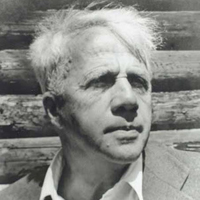Nothing Gold Can Stay by Robert Frost: Summary and Analysis
The poem Nothing Gold Can Stay, was published in the 'Yale Review', October, 1914, and in 'New Hampshire', 1923. This is compressed piece of poem where profound idea is simply put into the childlike rhyming words. In this poem, Frost explains that nothing on earth, especially that which is perfect and beautiful, can last forever. Everything has to go for transformation and has to change. It is a natural process.

Robert Frost (1874-1963)
He provides a number of examples of this: The first green of spring is her hardest hue to hold, So Eden sank to grief and So dawn goes down to day. All these phrases from the poem caters the meaning that nothing gold or good can last. The poem is about the fleeting nature of beauty and innocence. It focuses on the truth that change is inevitable and it involves degeneration. The change in nature and human life is a part of the glory of nature.
The fleetingness of gold, which is the symbol of wealth, has been emphasized in the poem. The first greenery of Nature is gold or riches. Gold is very difficult to hold. Nature's early leaf is a flower, which is to last only for an hour, no longer. Thereafter leaf is no more a flower; it is only a withered leaf. Out of greed, Eve became a victim of God's wrath and sank to grief. Similarly, dawn passes on to day and on. The lesson is that gold can halt, nothing from taking a natural course of action.
First of all, the quality that strikes in this poem is its remarkable brevity. Like Ice and Fire, it is a short poem packed with the hard core of wisdom. Nothing Gold Can Stay is an example of condensation in form and style. Not a single line is out of the context or lacking in symbolic significance. The entire, poem comprises barely eight lines. The poem, which belittles the importance and power of gold, is beautifully rhythmic and remarkably musical. Its rhyming arrangement is in the following pattern: a-a-b b-c-c-d-d
The entire poem is divisible. Metrically speaking, into two quatrains arranged in the form of couplets. Whether such a division is made or not, the total effect of the poem is very impressive. The lyrical delight of the poet in writing this poem is undeniable. But its lyricism should not blind the reader to believe that the poem is an outflow of an intense moment. It is rather emotion recollected in tranquility, to use the Wordsworthian phrase.
The great nature is symbolized here to show, the theme of life and death. All good and beautiful things of the life finally perish. All the things are transitory in nature. If one realizes how everything is fleeting from our life day by day and how precious is everything, then he will love to appreciate them even more.
Though on the surface, the speaker shows the depressing nature of every beautiful thing, in deep level, there is hope of next bright day. Spring flower may die, but will bloom next year. Children may grow old and die, but the next generation of kids will come with their innocence again.
The short and simple eight line childlike structure of the poem juxtaposes with the deep and insightful tone of the poem. In the first line of the poem 'Nature's first green is gold,' gold means good, perfect, beautiful and special. Here the speaker wants to say that the first green of the spring is precious and very amazing.
The poem has a moral to teach us, and it comes at the end with "Nothing Gold Can Stay." So man should not run after gold or riches so madly as he is seen today, keeping in mind its transitory nature.
Cite this Page!
Shrestha, Roma. "Nothing Gold Can Stay by Robert Frost: Summary and Analysis." BachelorandMaster, 26 Oct. 2017, bachelorandmaster.com/britishandamericanpoetry/nothing-gold-can-stay-summary-analysis.html.
Related Topics
The Silken Tent: Summary and Analysis
The Death of the Hired Man: Summary and Analysis
Neither Out Far nor In Deep: Summary and Analysis
West Running Brook: Summary and Analysis
Stopping by Woods on a Snowy Evening: Analysis
A Considerable Speck: Critical Analysis
Mending Wall: Summary and Analysis
Home Burial: Summary and Analysis
After Apple Picking: Summary and Analysis
The Road Not Taken: Summary and Analysis
Fire and Ice: Summary and Analysis
Acquainted with the Night: Summary and Analysis
The Gift Outright: Summary and Analysis
 |
bachelorandmaster.com |